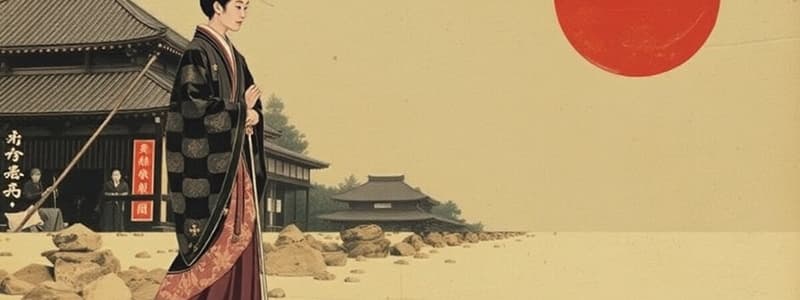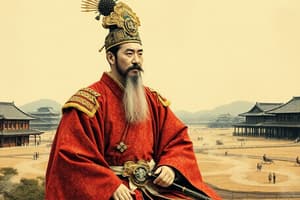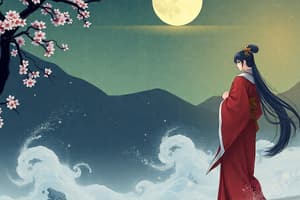Podcast
Questions and Answers
How did Kukai's return from China influence Japanese art during the Heian Period?
How did Kukai's return from China influence Japanese art during the Heian Period?
- It shifted the artistic focus towards abstract expressionism, moving away from representational forms.
- It fostered a focus on Shinto religious iconography, overshadowing Buddhist themes.
- It introduced new Buddhist teachings and opened Japan to foreign art forms, particularly influencing the popularity of mandalas. (correct)
- It led to a decline in artistic innovation due to strict adherence to Chinese styles.
What was the most notable contribution of Kukai to Japanese culture during the Heian Period?
What was the most notable contribution of Kukai to Japanese culture during the Heian Period?
- Developing the kana alphabet. (correct)
- Designing the architectural layouts of Heian-kyo.
- Establishing the tea ceremony.
- Promoting Confucianism as the state philosophy.
Which literary form saw significant development during the Heian Period, and who is its most celebrated author?
Which literary form saw significant development during the Heian Period, and who is its most celebrated author?
- Tanka poetry; Ki no Tsurayuki
- Haiku; Matsuo Basho
- Monogatari; Murasaki Shikibu (correct)
- Noh drama; Zeami Motokiyo
How did the cultural shifts during the Heian Period influence the identity of Japanese culture?
How did the cultural shifts during the Heian Period influence the identity of Japanese culture?
What distinguishes the kana alphabet, developed during the Heian Period, from the Chinese writing system?
What distinguishes the kana alphabet, developed during the Heian Period, from the Chinese writing system?
Flashcards
Heian Period
Heian Period
An era in Japanese history (794-1185) where intellectual artists established foundations for Japanese culture.
Kukai
Kukai
A Buddhist monk who brought new Buddhist teachings from China, influencing Japanese art and culture.
Mandalas
Mandalas
Representations of the spiritual universe, popularized in art and architecture during the Heian Period.
Kana Alphabet
Kana Alphabet
Signup and view all the flashcards
Monogatari Style
Monogatari Style
Signup and view all the flashcards
Study Notes
- The Heian Period in Japanese history (794-1185) saw intellectual artists establish many foundations for traditional Japanese culture.
- The Buddhist monk Kukai went to China and brought back new Buddhist teachings.
- His teachings greatly influenced Japanese art.
- Japanese art became extremely focused on representations of Buddhism.
- Buddhism also helped Japan open up to foreign art forms and styles.
- Mandalas, or representations of the spiritual universe, became very popular in art and architecture at this time.
- Kukai created an alphabet based on syllables and sounds, called the Kana alphabet.
- Japanese authors then used it to create a golden age of literature.
- Of particular note was the development of the Monogatari style of long fictional narratives.
- Murasaki Shikibu mastered this style and wrote The Tale of Genji.
- The Tale of Genji is still considered one of the great novels in history.
- The achievements of this era helped Japanese culture become the basis of what we still know as Japanese.
Studying That Suits You
Use AI to generate personalized quizzes and flashcards to suit your learning preferences.




